SWEDISH SOUTH ASIAN STUDIES NETWORK
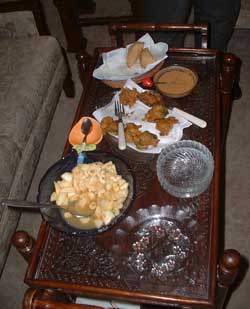
SASNET impressions from Pakistan and Afghanistan
Report from a fascinating contact journey
in November–December 2003
by Lars Eklund and Staffan Lindberg
| Pakistan/Karachi | Pakistan/Islamabad 1 | Pakistan/Lahore 1 |
| Afghanistan/Kabul | Pakistan/Islamabad 2 | Pakistan/Lahore 2 |
In the Spring 2002 we made a contact journey to four countries of the South Asian region. The purpose was to network with researchers and institutions, and get to know under which conditions and with what expectations they function.
We snowballed on the basis of our own and other Swedish researchers´ existing networks in South Asia. What difference could contacts and co-operation with Swedish researchers mean to them? Who could be possible partners in various projects and ventures?
Therefore it was quite natural that we now continued our efforts to create ties between researchers and academic institutions in Sweden and South Asia through another journey, this time to Pakistan and Afghanistan. We travelled for three weeks, met lots of people and had fascinating experiences. These are our impressions.
Pakistan/Karachi
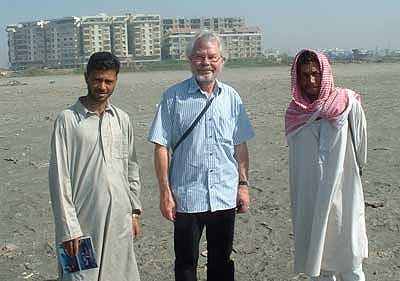 Our
tour to Pakistan started in the early hours
of Thursday 20 November 2003, by taking a taxi from Lund to Malmö,
train to Kastrup airport and a short SAS flight to Frankfurt in Germany.
From there we travelled by Gulf Air to Karachi, via the island kingdom
of Bahrain. We finally landed at Karachi’s Quaid-e-Azam International
Airport at 4 o’clock the next morning.
Our
tour to Pakistan started in the early hours
of Thursday 20 November 2003, by taking a taxi from Lund to Malmö,
train to Kastrup airport and a short SAS flight to Frankfurt in Germany.
From there we travelled by Gulf Air to Karachi, via the island kingdom
of Bahrain. We finally landed at Karachi’s Quaid-e-Azam International
Airport at 4 o’clock the next morning.
It was Friday 21 November, Jumatul Wida, the holiest of all Fridays
in the month of Ramadan (just before Eid ul Fitr), and there
were enormous queues by home-coming Pakistani guest workers from the Gulf
to every single immigration counter, even to the one labelled Diplomats/Businessmen
but once getting first in line it took only a few seconds to pass the
immigration official.
We were met by people from the Aga Khan University Conference Centre,
who brought us to the excellent guest house belonging to the Institute
of Educational Development (part of the Aga Khan University), situated
in a posh cantonment area of Karachi, southeast of the city centre, and
home to many famous persons like for example the president himself. We
felt safe within the walled and guarded compound.
We managed to get a few hours sleep before we again were picked up at
11 o’clock and brought to the other end of the city, where Aga Khan
Hospital and University are located. Inaugurated in 1985, the impressive
main buildings in red polished sandstone reminded us of the Mughal/Islamic
architectural heritage. Combined with modern architectural features and
well-equipped premises this gave a bright and welcoming impression. The
beautiful Karachi November sunshine, with an enjoyable 20 plus weather
and clean air in the surroundings, further helped us feel comfortable
despite our recent 30 hours journey.
Report from the visit to Aga Khan University 21 November 2003
Report from the visit to Karachi University 22 November 2003
On 23 November, Sunday morning, we went for a quick sightseeing tour of Karachi, before proceeding by an afternoon flight to the federal capital of Islamabad. Our Karachi taxi driver was given two hours to show us Saddar, the old town, other interesting places and also the Clifton beach. Read our reflections from the Karachi sightseeing!
Pakistan/Islamabad 1
We left Karachi by air to
Islamabad on 23 November in the late afternoon. By some
strange reason the officer at the PIA check-in desk at Karachi Airport
could not find our names in the computer, meaning we had no confirmed
reservations, but in a typical pragmatic way, characteristic of South
Asia, we were promised that things would turn out OK anyway.
So after waiting for an hour in the airport lounge, seats were arranged
for us and we were airborne again an hour before sunset. After a short
while plates of snacks were served, along with cool drinks. All passengers
on board happily accepted the snacks, but then sat back without touching
the food for another hour. The Ramadan fast was observed by everybody,
even children and what we considered to be a westernised elite. We felt
a bit awkward, like small children doing the forbidden thing, when we
had our bites and drinks in splendid isolation.
Then immediately after sunset a message in Urdu appeared on the loudspeaker.
Everybody eagerly grabbed their plates and started eating and drinking
just in time before the plane should land at Islamabad International Airport.
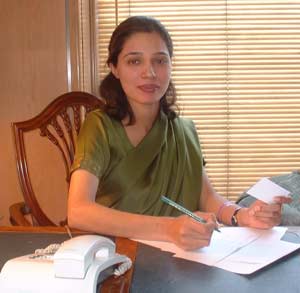 We
landed on time, and after a short taxi drive along a well-maintained highway
we arrived at Hotel Crown Plaza, a mid-range hotel in the Blue area of
Islamabad, where we were kindly taken care of by their charmingly sari-clad
employees – an unexpected feature in Pakistan (photo to the
left).
We
landed on time, and after a short taxi drive along a well-maintained highway
we arrived at Hotel Crown Plaza, a mid-range hotel in the Blue area of
Islamabad, where we were kindly taken care of by their charmingly sari-clad
employees – an unexpected feature in Pakistan (photo to the
left).
Dr. Ruth Laila Schmidt, from
the Dept of East-European and Oriental Studies, University of Oslo, Norway,
already waited for us in the foyer and later joined us for dinner. Ruth
was in Pakistan to see where her students from Oslo might be placed for
the study of Urdu. She was visiting various institutions, and was at the
time we met her inclined to make a memorandum of understanding (MOU) with
the University of Punjab in Lahore for this purpose.
Ruth is an old-time Pakistani visitor. She came here for the first time
already in 1964, and she has lived in Pakistan for altogether 15 years.
She now stayed with friends in Rawalpindi, Islamabad and Lahore. Her research
interest is focused ondialects of the Shina language spoken in the Kohistan
region of northern Pakistan. Along with two Pakistani researchers she
is working on a grammar for that language.
Ruth Schmidt is one of the panel convenors of the 18th European Conference
of Modern South Asian Studies in Lund in July 2004 (Panel
27. South Asian languages in linguistic focus).
The following day we had a full programme, visiting the
Swedish Embassy, and meeting several academic people.
Report from meetings in Islamabad Monday 24
November 2003
Pakistan/Lahore 1
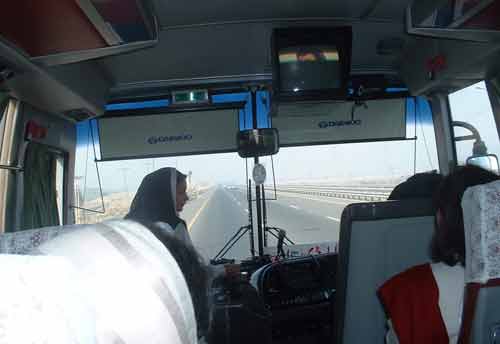 The
Korean Daewoo Express bus service
on Tuesday 25 November carried us comfortably on the new super express
highway built by Prime Minister Navaz Sharif in the 1990s (maybe one of
his few lasting legacies). It is South Asia’s best motorway and
the bus traversed without much shaking the 400 km long distance in just
4,5 hours, with a stop-over in a nice clean motel halfway, at Kallarkahar.
The
Korean Daewoo Express bus service
on Tuesday 25 November carried us comfortably on the new super express
highway built by Prime Minister Navaz Sharif in the 1990s (maybe one of
his few lasting legacies). It is South Asia’s best motorway and
the bus traversed without much shaking the 400 km long distance in just
4,5 hours, with a stop-over in a nice clean motel halfway, at Kallarkahar.
We arrived before the evening in Lahore, where we had reserved
rooms at the legendary Gymkhana Club located on the Mall. This is the
modern successor of the British club originally built in the late 19th
century. Colonial in style, with strict dress regulations (tie and suit
compulsory to use in the dining hall and the Chandni Lounge; no jeans
nor sandals permitted).
The club has all the activities a gentleman can require, including golf,
squash, a reading room, library with Internet facilities, a modern gym
in the basement, swimming pool, as well as restaurants, coffee shop, club
room, family room, verandah with a view, etc. The guest rooms are spacious
suites, but alás no BBC news was to be found among the 40 channels
available on the cable television.
The following morning we woke up leisurely. It was the first day of Eid-ul-Fitr,
the holiday celebrating the end of Ramadan. The Gymkhana Club was all
quiet, and we enjoyed a nice breakfast with toast and eggs and Nescafé,
reading the English language newspapers full of articles and commentaries
about Indo-Pakistani relations, as well as on the President and his proposed
Legal Framework Order (LFO), by many considered to sideline the constitution,
parliament and a democratic government system.
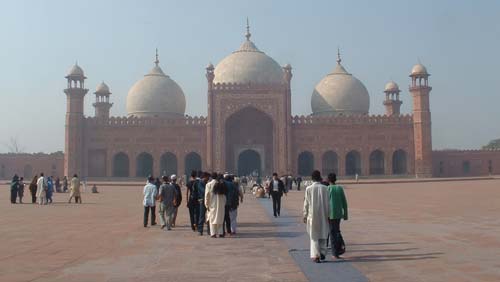 In
spite of the fact that it was Eid-ul-Fitr, meaning that all offices and
all universities are closed, we had managed to make a programme for the
day, meeting several people of relevance for SASNET.
In
spite of the fact that it was Eid-ul-Fitr, meaning that all offices and
all universities are closed, we had managed to make a programme for the
day, meeting several people of relevance for SASNET.
Report from meetings in Lahore Wednesday 26 November
2003
The next day, 27 November,
was the second day of the Eid festival and we also decided to keep half
a day off from official work and went sight-seeing Lahore. Mr. Saeed
Ahmad from the Punjab Tourism Development Corporation had promised
to show us around, taking us to the Lahore Fort, the Badshahi mosque and
the old town.
We went by motorised rickshaw to a taxi stand on the
Mall near the Anarkali market, from where we proceeded by taxi to the
Red Fort and the landmark of Lahore, the Badshahi Mosque.
 The
Badshahi Mosque built by Aurangzeb, the last
great Mughal emperor, in 1676 is big and imposing. It can easily house
around 100 000 people for prayer in its big square, and many had been
there just the day before at the Eid morning prayer.
The
Badshahi Mosque built by Aurangzeb, the last
great Mughal emperor, in 1676 is big and imposing. It can easily house
around 100 000 people for prayer in its big square, and many had been
there just the day before at the Eid morning prayer.
Opposite stands the mighty fort, Shahi Qila, given its
current form by the Emperor Akbar in 1566,
rebuilt by later Mughal emperors, by the Sikh king Ranjit
Singh and finally the British, who used it as a military fort till
1927 (when it finally was handed over to the Archaeology Dept.).
It reminded us of Agra and of Fatehpur Sikri. Lahore was one of the capitals
of the Mughals and they stayed here frequently for extended periods of
time, making Lahore a major centre of learning, art and music. We wandered
through courtyards of the Mughal families, the women’s garden, the
Palace of mirrors … and ended by the picture wall where birds also
had their nests. Here was the entrance of the royal family carried by
elephants up the broad stairs to their quarters.
Lahore continued to
be the centre of the Northwestern part of India during British rule. Many
new buildings, including university colleeges and the famous Lahore Museum
(where Rudyard Kipling’s father was
the curator), were added to the Mughal ones making the city truly magnificent
even today. The broad and lofty roads and avenues, the cleanliness of
the city and the friendliness of its people all impress and leave a lasting
memory.
We had excellent Kashmiri chai with herbs at the so-called Food Street,
and then went for a walk through the old city, entering through the Delhi
Gate. Narrow lanes and lines of small shops but since this was an Eid
holiday not much people nor vehicles thronged the narrow passages. We
came to the open square outside the famous Wazir Khan mosque, where a
lot of people had gather enjoying their holiday. We went inside the beautiful
mosque decorated all over with mosaic figures, and sat down on a mat in
the main prayer hall and watched the open yard outside, and had a friendly
chat.
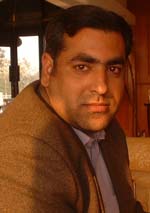 In
the afternoon we met Mr. Ali Raza,
a journalist working at the daily newspaper
The News in Lahore. He is just 31 years old, but already has a long
experience as a journalist. He started off as a journalist specialised
on crime reporting, but later changed into business, energy, water, and
more recently rural development.
In
the afternoon we met Mr. Ali Raza,
a journalist working at the daily newspaper
The News in Lahore. He is just 31 years old, but already has a long
experience as a journalist. He started off as a journalist specialised
on crime reporting, but later changed into business, energy, water, and
more recently rural development.
Raza told us about the great problems journalists have in pursuing their
profession in Pakistan. Journalists are also vulnerable because of their
low pay and uncertain employment situation, and even the newspapers face
economic difficulties, since the government and others may withhold advertisements
when displeased with the content of the paper.
Despite his young age, Ali Raza has an advanced and critical understanding
of recent developments in Pakistan.
Friday 28 November was a hectic day.
In the morning we visited the National College of Arts (NCA), meeting
Prof. Ajaz Anwar, then we had a lunch meeting
with the faculty of NCA at Dr. Durre S. Ahmed’s
residence. After that a meeting with Prof. Sajjad
Naseer and colleagues at Gymkhana Club, and finally a meeting at
the Punjab Club with Professors Fehmida Jalil
and Shaukat Raza Khan in the evening.
Full reports from meetings in Lahore Friday 28
November 2003
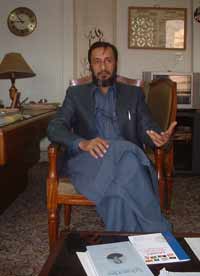 On
Saturday 29 November we had an appointment to visit the Iqbal Academy
Pakistan. Its Director, Mr. Muhammad Suheyl
Umar (photo to the right), picked
us up at Gymkhana Club and brought us to the Aiwan-i-Iqbal Complex, in
which Iqbal Academy is situated. The complex is nice three-towered building,
which also houses a big auditorium and seminar halls, in the centre of
town, opposite to Faletti’s Hotel.
On
Saturday 29 November we had an appointment to visit the Iqbal Academy
Pakistan. Its Director, Mr. Muhammad Suheyl
Umar (photo to the right), picked
us up at Gymkhana Club and brought us to the Aiwan-i-Iqbal Complex, in
which Iqbal Academy is situated. The complex is nice three-towered building,
which also houses a big auditorium and seminar halls, in the centre of
town, opposite to Faletti’s Hotel.
The Iqbal Academy is caretaker of the legacy of Allama
Muhammad Iqbal, the poet philosopher and spiritual father of Pakistan.
The Academy publishes books and journals about Iqbal, networks with the
departments of Iqbal studies in the various universities of Pakistan,
and organises seminars and conferences. It is also networking with foreign
scholars who work on Iqbal. It has a library, it publishes cd:s and it
is bringing Iqbal online. (http://iqbalcyberlibrary.net/)
In Pakistan, Iqbal has become the public hero, comparable to Mahatma
Gandhi in India. Recently there has been a controversy about the
role of Iqbal in the creation of Pakistan, but Umar has recently published
a booklet called ‘Iqbal and the concept of Pakistan’
(2002) in which he refutes these ideas.
Religion is the basis of nationalism.
If the stars are not bound to each other,
there is no star-lit sky.
Arise! Emancipate the wretched of the earth by the power of Ishq
and enlighten the world with the name of Muhammad.
Be faithful to Muhammad, and we yield ourself to you;
not this world alone – the Tablet and the pen your prize shall be.
(Jawab-i-Shikwah, Answer to the complaint)
We returned to Islamabad
on Sunday 30 November, once again by a comfortable Dawoe
Express bus.
In the evening we were once again invited by Ms. Nasim
Zehra for a dinner meeting with some prominent researchers in Islamabad:
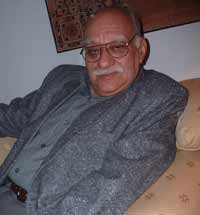 •
Dr. Rifaat Hussain, Professor & Chairman,
Department of Defence and Strategic Studies, Quaid-i-Azam University (note
that this study department at Quaid-e-Azam University has no links with
the Institute of Strategic Studies, also to be found in Islamabad, which
is a research institution closely connected to the Pakistani government
and its official policies)
•
Dr. Rifaat Hussain, Professor & Chairman,
Department of Defence and Strategic Studies, Quaid-i-Azam University (note
that this study department at Quaid-e-Azam University has no links with
the Institute of Strategic Studies, also to be found in Islamabad, which
is a research institution closely connected to the Pakistani government
and its official policies)
• Dr. Dushka H. Saiyid, Chairperson,
Department of History, Quaid-i-Azam University
• Dr. Khalid Mahmud, Research Analyst,
Institute of Regional Studies
We had a very interesting discussion about the ongoing
reconciliation process in Indo-Pak relations. Khalid
Mahmud (photo to the left), senior professor at the well-reputed
Institute of Regional Studies, and previously also editor of the daily
newspaper The Nation, turned out to be extremely well-informed about regional
politics. He argued that there are differing communal relations in different
parts of India, and in his opinion the state of Gujarat is an exception
from the rule in Indian politics. He has travelled extensively all over
the region.
The institute is funded by the government but is run independently, and
it carries out research not only on South Asia, but also since the past
4–5 years to a certain extent on China and Central Asia.
Dr. Rifaat Hussain informed us about the
institutional setup at Quaid-e-Azam University within the fields of social
sciences and area studies. The university runs two area studies centres;
one on North America, South America and Africa (!), and one on Pakistan
Studies. In the social sciences field an exchange of scholars regularly
take place with France and Germany.
Rifaat also mentioned that an Area Studies Centre for Central Asia exists
at Peshawar University, which we unfortunately had no time to visit.
On Monday 1 December we spent the
morning at Hotel Crown Plaza, and had a meeting with Dr. Qasim
Ayub, Deputy Director, Biomedical & Genetic Engineering Division,
Dr. A. Q. Khan Research Laboratories,
Rawalpindi. The Laboratories, founded by – and named after –
the controversial Abdul Qadeer Khan, the
father of the Pakistani nuclear bomb, are more commonly known as the Kahuta
laboratories). It is a fairly new institute, small in size, but with very
qualified researchers and modern equipment. It is interested in collaboration
with similar institutes. We were supposed to visit the laboratory but
due to technical problems it could not materialize.
More
information on A.Q. Khan, and Pakistan's nuclear weapons program,
which has been a source of extreme national pride in Pakistan.
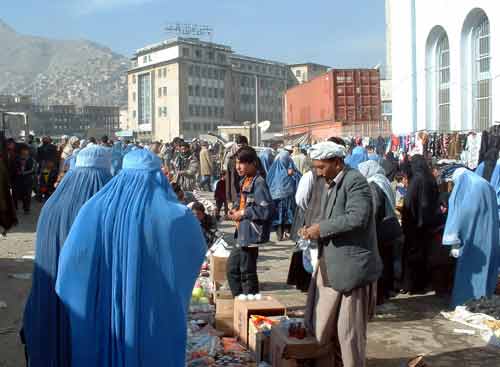 Afghanistan/Kabul
Afghanistan/Kabul
The Ariana Afghan Airlines
flight to Kabul took off at about 13.00 on Monday 1 December
2003, and after nice overview over the plains of Punjab and NWFP and of
the mountain ranges separating Pakistan and Afghanistan (with snow covered
mountain tops), we landed in the valley of Kabul.
After landing we proceeded to the Swedish Committee for Afghanistan
(SCA) compound in Shar-e-Nau where we were accommodated during our stay
in Kabul.
In the afternoon we had an appointment the Swedish Counsellor Jörgen
Persson at the local Sida office, and in the evening we met the
staff at SCA.
Report from meetings in Kabul Monday 1 December
2003
On Tuesday 2 December we
visited the Afghanistan Research and Evaluation Unit, AREU, in
the morning; and in the afternoon we had a meeting with Dr Sharif
Fayez, Afghanistan’s Minister for Higher Education. In the
evening we met a few expatriate scholars staying in Kabul.
Report from our meetings in Kabul Tuesday 2 December
2003
The following day was mainly devoted
to visiting Kabul University and its faculties. We also visited
the National Centre for Policy Research and were impressed by its ambitious
programme to train Afghani researchers. In the evening we met some expatriate
Swedish experts.
Report from our meetings in Kabul Wednesday 3 December
2003
On Thursday 4 December Staffan returned
to Islamabad by the PIA flight at noon, whereas Lars stayed on
in Kabul for another three days. Before we parted there was however still
an appointment that we were happy about, namely a meeting with Nancy Dupree
at the Swedish Committee for Afghanistan office. Nancy had just flown
in from Peshawar to give a lecture at the Afghanistan Academy of Sciences.
Report from our meeting with Nancy Dupree,
Thursday 4 December 2003
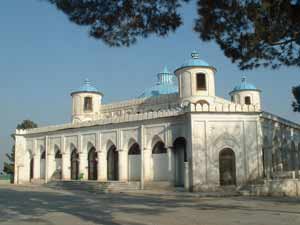 Lars
enjoyed staying more days in Kabul, having plenty of time walking
around in the city and visiting interesting places in the Afghan capital
that he had previously visited 28 years ago, including the Bagh-e-Bala
palace on a hillock with a grand view over Kabul (photo to the right).
Lars
enjoyed staying more days in Kabul, having plenty of time walking
around in the city and visiting interesting places in the Afghan capital
that he had previously visited 28 years ago, including the Bagh-e-Bala
palace on a hillock with a grand view over Kabul (photo to the right).
On Sunday 7 December he then departed for New Delhi, India with once-weekly
Ariana Afghan Airlines jumbo-jet flight. From there he proceeded to his
beloved Kolkata to spend his holiday there before returning to Sweden
in the beginning of January 2004.
Read Lars Eklund’s
article on Kabul Revisited, published in SYDASIEN 4/2003
(in Swedish only)
Pakistan/Islamabad 2
Staffan returned to the Pakistani
capital Islamabad on Thursday 4 December, in order to
participate in a meeting at the Quaid-e-Azam University the following
day. The reason for arranging the meeting now, after the completion of
our Afghanistan tour, was that due to the Eid festival no such gathering
of prominent Islamabad scholars could be materialized during our previous
visit to the capital city.
Report from meeting at the Quaid-e-Azam
University in Islamaba Friday 5 December 2003
Pakistan/Lahore 2
Lahore became the final destination
of our contact journey 2003. Staffan had to return to
the city, this time by domestic flight, in order to have a meeting with
scholars from Punjab University, and King Edward Medical College; and
visit the Lahore School of Economics. This was not possible during our
first stay in Lahore due to the Eid festival.
After completing his mission in Lahore Staffan returned once again to
Islamabad, from where he flew back with Gulf Air to Sweden in the early
morning of Monday 7 December.
Report from Staffan’s meetings
in Lahore Sunday 6 December 2003
SASNET - Swedish South Asian Studies Network/Lund
University
Address: Scheelevägen 15 D, SE-223 63 Lund, Sweden
Phone: +46 46 222 73 40
Webmaster: Lars Eklund
Last updated
2011-04-08
